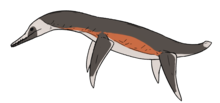Pahasapasaurus is a genus of polycotylid plesiosaur from the late Cenomanian-aged Greenhorn Limestone of South Dakota, USA, about 94 million years ago. Distinctive features of the taxon include elongate epipodial bones (radius/ulna - tibia/fibula) and the nature of the palate bones (roof of the mouth). The type species is P. haasi.[1]
| Pahasapasaurus Temporal range: Late Cretaceous, late
| |
|---|---|

| |
| Life restoration | |
| Scientific classification | |
| Domain: | Eukaryota |
| Kingdom: | Animalia |
| Phylum: | Chordata |
| Class: | Reptilia |
| Superorder: | †Sauropterygia |
| Order: | †Plesiosauria |
| Family: | †Polycotylidae |
| Genus: | †Pahasapasaurus |
| Species: | †P. haasi
|
| Binomial name | |
| †Pahasapasaurus haasi Schumacher 2007
| |
In August 1934, entrepreneur Charles Christian Haas and his son Arthur while searching for shark teeth discovered a plesiosaur skeleton near the Maloney Creek, south of the Belle Fourche River in the northern Black Hills. They collected and partially prepared the specimen, studying the relevant scientific literature to better understand the bones and documenting the dig via photographs and matrix samples. A report was written, published by the Science Service Bureau. Haas hoped to sell the specimen to some museum but when no buyer showed interest, he donated it to the Pioneer Museum at Deadwood, the present Adams Museum & House. By 1937 it had been identified as Trinacromerum bentonianum by Stephen Chapman Simms, the director of the Field Museum.
In 1996, museum director Mary Kopco, in cooperation with the Haas family, decided to restore the specimen. Dr Gordon Bell of the South Dakota School of Mines and Technology in Rapid City headed the project which was actually carried out by his student Bruce Schumacher. Schumacher quickly concluded from the morphology of the fins that it was not Trinacromerum but a species new to science which he reported in 1997.[2] Preparation continued in a Disney World laboratory open to the public. Parts of the vertebral column were still covered by sugar sacks and paste. From the other bones thick layers of shellac had to be removed. Ultimately, the fossil was again exhibited in the AMM.
In 2007, Schumacher named Pahasapasaurus haasi. The generic name is derived from Paha Sapa, meaning "Black Hills" in the Sioux language. This name was chosen by the Haas family, because Charles Haas had always been interested in the Lakota archeology of the Black Hills. The specific name honours C.C. Haas as discoverer.
The holotype is AMM 98.1.1, a partial skeleton with skull and lower jaws.
See also
editReferences
edit- ^ Schumacher, B. A. 2007. A new polycotylid plesiosaur (Reptilia; Sauropterygia) from the Greenhorn Limestone (Upper Cretaceous; lower upper Cenomanian), Black Hills, South Dakota. in Martin, J.E., and Parris, D.C., eds., The Geology and Paleontology of the Late Cretaceous Marine Deposits of the Dakotas: Geological Society of America Special Paper 427, p. 133-146.
- ^ Schumacher, B.A., 1997, "A new short-neck plesiosaur from the basal Greenhorn Limestone (Upper Cretaceous) of South Dakota", Kansas Academy of Science Transactions (abstracts), 16: 39